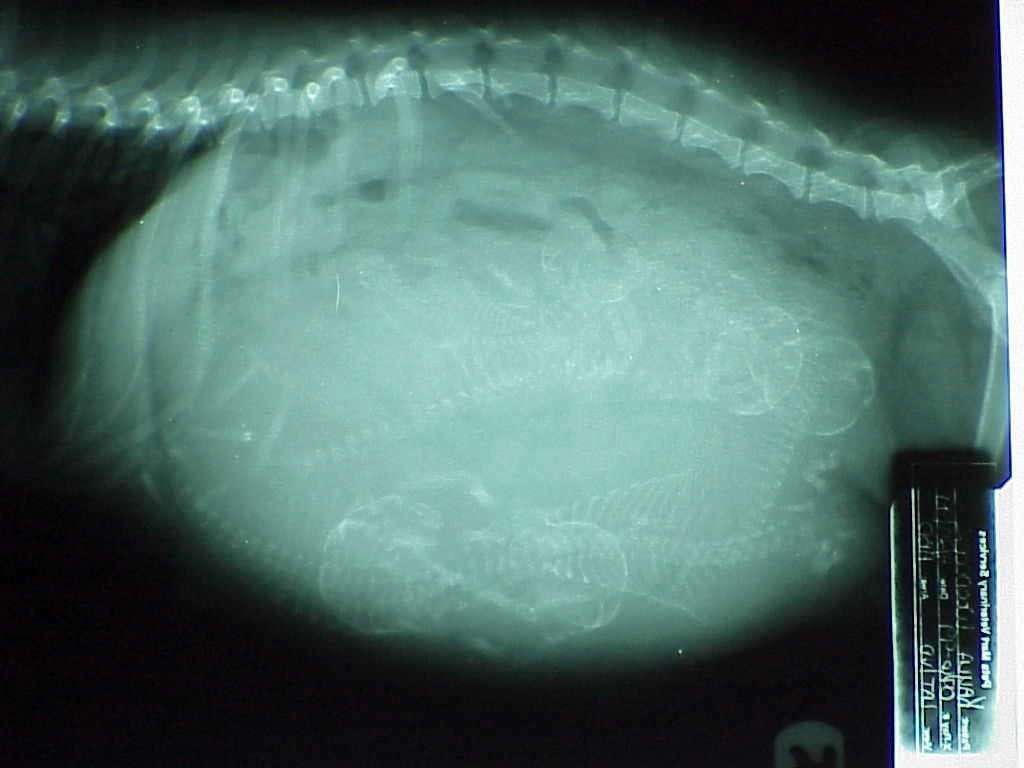Pregnancy
The average normal pregnancy period, for dogs is 63 days and cats, 60 days. During the first 40-45 days, you will not notice an overwhelming change in your pet’s health or needs. She may begin nesting and begin mild mammary development, but her dietary and physical needs should not change very much. A real change in her diet should not be made until her last 2-3 weeks of pregnancy. Puppy foods that are also suitable for the pregnant and lactating bitch are the best e.g. Hill’s puppy. Over-feeding your pet before this time will just make her obese and potentially cause troubles giving birth.
To confirm pregnancy:
- Pregnancy Check (24-35 days): The fetuses are usually palpable between 21-31 days. However some pregnancies are hidden under the mother’s rib cage or are not so easily palpable.
- Ultrasound exam (30 days): Ultrasound can be used to confirm pregnancy although not always to confirm the number of pups.
- Pregnancy Check / X-ray (45-55 days): The fetuses are now visible on x-ray and allow your veterinarian to approximate size and number of fetuses. This will also allow your veterinarian to discuss diet going into the pets’ last trimester of pregnancy.
Labour: There are two phases of labour common to most animals. The first phase can be seen as early as a day or two before full labour. Excitement, nest building, anxiety, decreased appetite, vomiting and restlessness are part of this first phase. This phase can last for a very long time and your pet can prolong this period if she feels nervous or unsure of her environment. The second phase of labour starts with the first abdominal contraction and push. Once abdominal pushing beings your pet should:
- If this is your pet’s first litter, she should produce a first puppy or kitten in 4 hours and average one kitten or puppy every other hour.
- If your pet has already had its first litter, she should produce her first off-spring within 2 hours and average one kitten or puppy every other hour.
When the pups or kittens are born, 40% are born breach (backwards) and this is completely normal. Each pup will have a placenta around it with its own fluid. The normal placental pigments are black and green and this does not suggest problems with the pup or kitten. If possible allow your pet to break the placenta by herself by licking the new pup or kitten. It is common for your pet to eat the placenta. This can also produce black or green diarrhoea in the next 1-2 days in the mother. Read about Whelping (Canine).
Cause of Dystocia (Trouble giving birth): One of the most common causes of dystocia is a large size difference between the father and the mother, or breeding the female too young. It is not recommended to breed bitches and queens until the third heat.
Signs of Dystocia:
- If your pet begins active labor and does not produce a pup or kitten in the first 3 ½ hours, with the first pregnancy, or first 1 ½ hours if your pet has had one or more pregnancies already.
- If there is a pup or kitten partially out of the vulva but seems to be wedged.
- If your pet is straining without producing a pup and is becoming weaker, lethargic or shaking excessively.
- If your pet stops contracting for a long period of time (greater than 1 hour) and you know there are more neonates to come.
- If there is a bloody / purulent vaginal discharge.
Please contact your veterinarian immediately if any of these signs occur or if you have any concerns.
If no signs of labour have begun just following the 63 days of pregnancy please contact the clinic.

